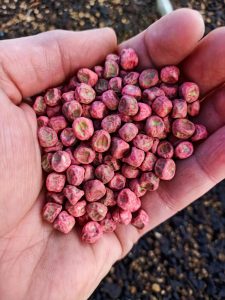How long do seeds last?
Seed Viability and Vigour
(Taken from An Introduction to Seed Saving: Nourish Workshop May, 2021)
Seed viability and seed vigour are not the same thing. Viability refers to a seed’s ability to germinate, whereas vigour refers to the overall health and vitality of the seedling. At high germination percentages (above 80%), viability and vigour are at their peak, but as the seeds age, their vigour declines more rapidly than their viability.
The seed may still germinate, but as vigour declines, the seeds germinate into stunted, deformed, weak seedlings. The longer the seeds are stored, the greater the decrease in viability and vigour. When germination percentage declines to about 20%, vigour is almost completely lost and there is little point in keeping the seed.
Seeds of many weed species can remain viable in the soil for 50 years, but for most vegetable plants the average seed life ranges from 3-10 years, depending on storage conditions. Here are some factors that influence seed storage-ability:
Moisture, heat, and fluctuating temperatures all reduce seed viability. The seed’s metabolism must slow as much as possible without damaging the embryos. We usually do this by providing cool, dry conditions.
Seed Physiology: most veggie seeds are “orthodox” which means they generally store best in cool, dry, dark conditions.
The type of seed coat it has is one factor that helps preserve seed viability. Seed coats keep out moisture and oxygen, which in turn keeps metabolism at a low rate inside the seed. Hard seed coats also keep the embryos safe from damage during collection and cleaning. The thinner and softer the seed coat the more likely it is to have a shorter storage life.
Oily vs starchy: oily seeds such as sunflowers do not store as well as starchy seeds like peas.
Seed maturity: immature seeds do not store well.
Plant type: it is important to know how long seeds from some plant families are likely to keep in order to know how long you can keep your purchased seed packets for (you do not have to use the whole packet all at once), and also to plan what crops you need to save seed from year to year. Parsnip seed is viable for one year only.
Seeds from the onion family are viable for up to two years. Beets, peas and beans for 3 years, and Brassicas for at least 4 years.
Test seed viability with the rag-doll test: Count out 10 seeds and fold them up in a paper towel. Moisten it, and place the “rag-doll” into a zip-lock plastic bag or jar, and leave it on the kitchen window sill or bench for one week. Count how many seeds have germinated. If 8 out of the 10 germinate, you have an 80% germination rate. You then know the viability of your seed. You can do this test before you sow seed, or before you store it.
“We are the ancestors; we are the human link between past and future. The seeds of our ancestors will only be available to nourish our grandchildren if we save them today. It’s up to us!” Kay Baxter, Koanga Institute

